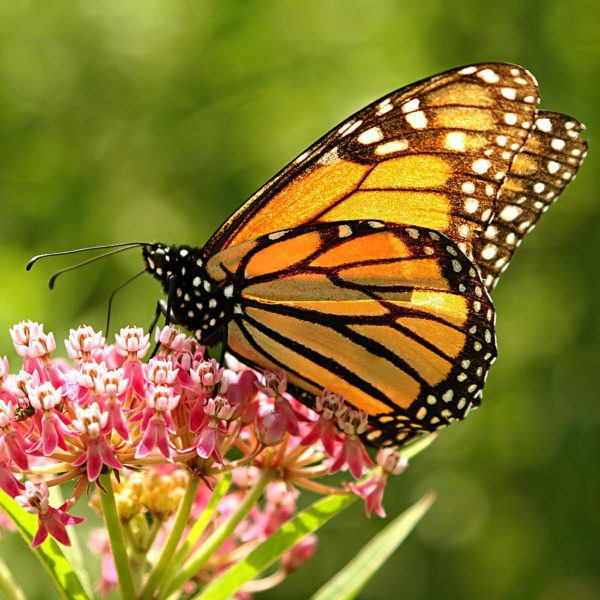
Listen to this Episode:
- From this webpage:
- Find the media player located under the episode picture.
- Click on the green triangle to listen to the audio for this episode.
- From your favorite podcast listening platform:
- Search for “Backyard Ecology.”
Show notes:
Hi Everyone! Today we are talking with Dr. Adam Baker who recently completed his PhD studying monarch butterflies and their use of monarch waystations in urban and suburban areas. His research has led to some important and easily applied strategies that any of us can use in our gardens.
First, Adam looked at existing monarch waystations. He wanted to determine if monarchs used monarch waystations and if there were any key characteristics that might make one monarch waystation more successful than another. He found two very important characteristics that increased monarch butterfly use of the gardens for egg laying. First, more eggs were laid on milkweeds that were isolated from other plants – in other words, not touching other plants. Second, monarch waystations with clear lines of sight in the north-south directions were used much more than waystations where those lines of sight are blocked.
Next, Adam looked at ways to design monarch waystations or pollinator gardens that would make them more attractive to egg laying monarchs. His research found that planting milkweed around the perimeter of the garden resulted in more monarch caterpillars and eggs than gardens where the milkweed was planted as a clump in the middle or mixed up with other plants throughout the monarch waystation.
Additionally, he compared monarch egg laying behavior and bee usage of different species of milkweed and even compared some of the milkweed cultivars with their wild type counterparts. His research showed that tall, broad leaf species were more attractive to egg laying butterflies, than species with shorter or narrower leaves. The species of bees that used the different types of milkweed also varied.
Yet another, component of Adam’s research looked at European paper wasp predation of monarch caterpillars. He found that butterfly houses or butterfly hibernation boxes – those long, skinny houses with slits in the front or side that are often placed in or near pollinator gardens or monarch waystations – are commonly used by European paper wasps. There’s no evidence that butterfly houses or hibernation boxes are actually used by butterflies. Thus, placing one in your monarch waystation or pollinator garden might be providing additional habitat for caterpillar predators while not doing anything to help monarchs or other butterflies.
I love how Adam’s research provides us with applicable, hands-on activities we can do to support egg laying monarchs in our gardens. I also like that part of his research looked at bee usage of milkweeds because obviously milkweeds are used by more than just monarchs. Adam’s research is another example of how much we still have to learn about gardening for pollinators and wildlife, even for something as iconic and popular as the monarch butterfly. To me, it’s exciting to see more of this type of research being done, especially when it results in real-world applications that we can so easily use in our own yards and communities.
Links:
- Adam’s papers and resources
- Backyard Ecology’s website
- My email: shannon@backyardecology.net

Backyard Ecology: Exploring Nature in Your Backyard
Nature isn’t just “out there.” It’s all around us, including right outside our doors. Hi, my name is Shannon Trimboli, and I am the host of Backyard Ecology. I live in southcentral Kentucky and am a wildlife biologist, educator, author, beekeeper, and owner of a nursery specializing in plants for pollinators and wildlife conservation. I invite you to join me as we ignite our curiosity and natural wonder, explore our yards and communities, and improve our local pollinator and wildlife habitat. Learn more or subscribe to my email list at www.backyardecology.net.

Leave a Reply